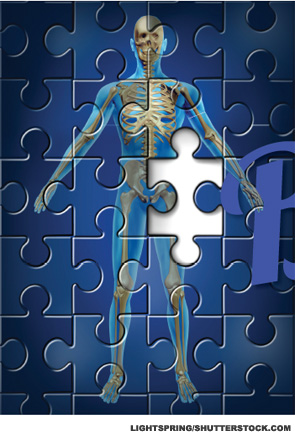
Hip-resurfacing (HR) arthroplasty is a procedure that preserves bone and allows patients to return to a higher level of function with a longer prosthesis life compared with patients who receive a total hip arthroplasty (THA).1 It’s considered an alternative to THA in a select group of patients who might potentially outlive a THA.1
During HR, the femoral neck is preserved, and the femoral head is shaped and capped with a metal device and short stem. The acetabulum is also lined with a specific metal device.2 There are several types of hip-resurfacing systems.
The U.S. Food and Drug Administration (FDA) has approved three metal-on-metal (MoM) hip-resurfacing systems in the U.S.: the Birmingham (BHR), the Cormet and the Conserve-Plus hip-resurfacing systems.3 The ideal candidate for the BHR system is an active male, younger than 65 years old, with osteoarthritis and relatively normal bone morphology who has not improved with conservative treatment.4
Contraindications to HR include being female of childbearing age, osteonecrosis involving more than 50% of the femoral head, impaired renal function, severe osteoporosis and known metal sensitivity.4
Case Description
The patient was a 55-year-old male who presented to physical therapy (PT) with a chief complaint of progressively worsening left hip pain for 20 months. He reported left groin and posterolateral deep hip pain that was exacerbated by prolonged walking, sitting, running, squatting, pivoting off the left leg, descending stairs and activities of daily living (ADLs). He reported that pain improved with stretching, ice, use of ibuprofen or acetaminophen and non-weight-bearing exercise. The patient’s goals were to decrease pain, improve function and return to daily running, exercise and strength training.
On examination, the patient had a mild antalgic gait, positive left hip scour test, positive anterior pelvic tilt, decreased left hip strength and range of motion and decreased joint play. The hypothesized underlying condition was left hip osteoarthritis. The patient’s preoperative PT consisted of passive hip range of motion, muscle energy techniques, hip mobilization, including long axis and lateral distraction, progressive therapeutic strengthening and a stretching program. Electrical stimulation and ice were used as an adjunct for pain relief.
The patient did not improve significantly with skilled PT and was referred to an orthopedic surgeon. Radiographs (see Figure 1) showed osteoarthritis of the acetabulum and femoral head, decreased joint space and osteophyte formation on the acetabular rim. Surgical options for the patient included HR or a THA.
Due to the patient’s age, physical fitness and activity, good bone density and goal of returning to sports and high-level activities, such as running, he was determined to be a good candidate for HR.

